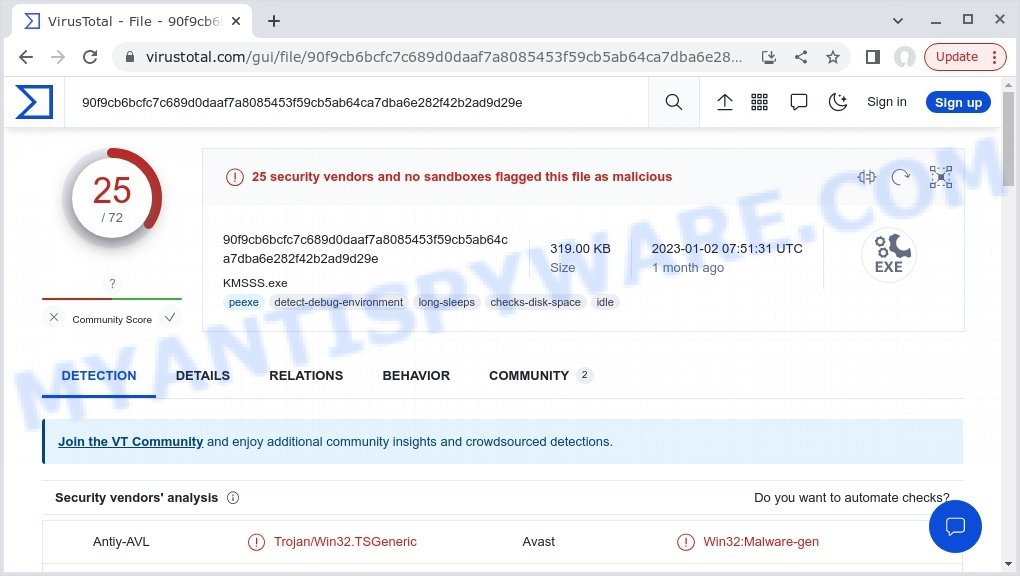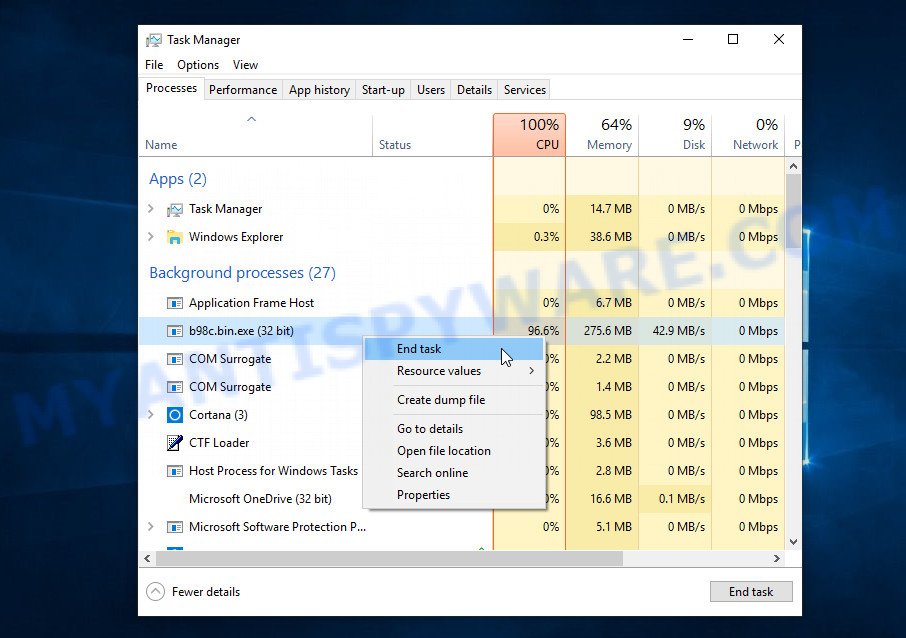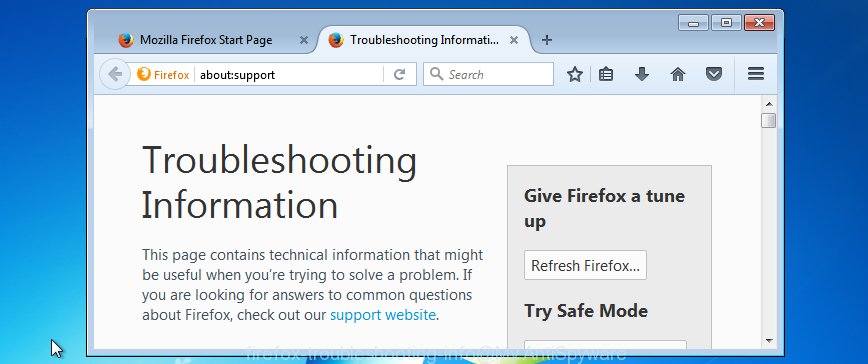What is HackTool:Win32/Keygen?
HackTool:Win32/Keygen is a malware that can infect a computer through the use of cracks or key generators to activate premium software. It is a dangerous program that is categorized as a severe threat by Microsoft Defender, and it can automatically create executable files within the key generator or the activated software, which are hard to locate and remove.
The malware can lead to serious consequences such as data loss and identity theft. In this article, we will provide more information about HackTool:Win32/Keygen, how it infects a device, and what can be done to remove it.
VirusTotal flagged HackTool:Win32/Keygen as malware:

QUICK LINKS
- What is HackTool:Win32/Keygen?
- HackTool:Win32/Keygen in detail
- How to remove HackTool:Win32/Keygen
- Tips to Prevent Infection
HackTool:Win32/Keygen in detail
HackTool:Win32/Keygen is a software that enables users to illegally register different applications by forging activation keys or license files to bypass the activation process. Although the tool itself is not inherently harmful, it is often distributed alongside viruses. A recent report by Microsoft indicates that more than 50% of computers that use this tool are infected with various types of viruses, each exhibiting different behaviors. For instance, some viruses encrypt data and make ransom demands, while others secretly mine cryptocurrencies, record personal information, and perform other malicious activities such as trojan attacks. As such, it is critical to exercise caution when using this tool to avoid infecting your device with viruses.
The following is an example of a key generator for Adobe Photoshop:

HackTool:Win32/Keygen malware is categorized as a severe threat by Microsoft Defender due to its ability to automatically create executable files within the key generator or the activated software, which are hard to locate and remove. Although Microsoft Defender often quarantines this threat, which limits its ability to spread further, it cannot automatically remove it. Therefore, it may be found on your device every time you run a scan. The only way to completely remove the malware from your device is by taking the manual route.
The malware is often bundled with key generators and other viruses, and it can infect a device when users download and install such programs on their devices, unknowingly allowing viruses to invade them. Many HackTool:Win32/Keygen users have their computers infected with other viruses.
The main reasons for computer infections are lack of knowledge and careless behavior. Therefore, caution is key to safety. Users should pay close attention when downloading/installing software and browsing the Internet, carefully analyzing each download/installation step and declining offers to download/install third-party programs. We recommend downloading applications from official sources only, using direct download links, and using only legitimate software, never using unofficial activation/update tools.
Having a reputable anti-virus/anti-spyware suite installed and running is also paramount, since these tools can detect and eliminate malware before it does any damage. If you believe that your computer is already infected, we recommend running a scan with a reputable antivirus to automatically eliminate infiltrated malware.
Threat Summary
| Name | HackTool:Win32/Keygen |
| Type | malware |
| Detection names | Trojan/Win32.TSGeneric, Win32:Malware-gen, Riskware/HackKMS, HackTool.Win32.AutoKMS, Trj/GdSda.A, Hacktool.Kms, Hack.Win32.KMS.vl!n, A Variant Of Win32/HackKMS.W Potentially Unsafe |
| Distribution | Bundled with fake key generators or cracks on third-party websites |
| Symptoms | Automatic creation of executable files, system slowdowns, pop-up ads, unauthorized changes to the system |
| Damage | Data loss, theft of personal and financial information, compromised system security |
| Removal | Use a reputable antivirus software to detect and quarantine the malware. Manually remove the malware by locating and deleting any related files. |
Examples of malicious programs
On the Internet, users can come across many malicious programs that perform various malicious actions. Among them there are such as WhiskerSpy Backdoor Malware, WlndowsDraiver Virus, Altruistics Virus, Trojan Wacatac, although, of course, there are many more. Some of them collect user data, others install malware on computers, and still others add infected computers to botnets, and so on. In any case, each malicious program (adware, browser hijacker, trojan, worm, …) is a huge threat to both user privacy and computer security. Therefore, malicious programs must be removed immediately after detection; using an infected computer is very dangerous.
How to remove HackTool:Win32/Keygen from computer (Malware removal guide)
If you suspect that your computer has been infected with the HackTool:Win32/Keygen malware, it is important to take the following steps to remove it: update your antivirus software, delete the malware manually, restore System Settings, change Passwords.
To remove HackTool:Win32/Keygen, use the following steps:
- Kill HackTool:Win32/Keygen process
- Disable HackTool:Win32/Keygen start-up
- Uninstall HackTool:Win32/Keygen related software
- Scan computer for malware
- Reset Google Chrome
- Reset Firefox
Kill HackTool:Win32/Keygen process
Press CTRL, ALT, DEL keys together.

Click Task Manager. Select the “Processes” tab, look for “HackTool:Win32/Keygen” then right-click it and select “End Task” or “End Process” option. If your Task Manager does not open or the Windows reports “Task manager has been disabled by your administrator”, then follow the guide: How to Fix Task manager has been disabled by your administrator.

This malware masks itself to avoid detection by imitating legitimate Microsoft Windows processes. A process is particularly suspicious: it’s taking up a lot of memory (despite the fact that you closed all of your applications), its name is not familiar to you (if you’re in doubt, you can always check the program by doing a search for its name in Google, Yahoo or Bing).
Disable HackTool:Win32/Keygen start-up
Select the “Start-Up” tab, look for something suspicious that is the HackTool:Win32/Keygen malware, right click to it and select Disable.

Close Task Manager.
Uninstall HackTool:Win32/Keygen related software
Check the list of installed apps on your computer and remove all unknown and recently installed apps. If you see an unknown program with incorrect spelling or varying capital letters, it have most likely been installed by malware and you should clean it off first with a malware removal utility such as MalwareBytes Anti-Malware.
|
|
|
|
Scan computer for malware
Antivirus software is a great method to remove HackTool:Win32/Keygen because it’s designed to detect and remove malicious software, including trojans and spyware. The software uses a database of known threats and virus definitions to identify and remove any malicious software that is present on your computer.
Additionally, antivirus software has the ability to scan your entire computer, including all files and system areas, to detect and remove any hidden or persistent threats. This is important because browser hijackers can often hide themselves and change system settings to make them difficult to remove.
You can remove HackTool:Win32/Keygen virus automatically with the help of MalwareBytes AntiMalware. We recommend this malware removal utility because it can easily remove spyware, trojans, browser hijackers, adware, PUPs and toolbars with all their components such as files, folders and registry entries for free.

First, visit the page linked below, then click the ‘Download’ button in order to download the latest version of MalwareBytes.
327280 downloads
Author: Malwarebytes
Category: Security tools
Update: April 15, 2020
Once the downloading process is complete, run it and follow the prompts. Once installed, MalwareBytes will try to update itself and when this procedure is done, click the “Scan” button to perform a system scan for the HackTool:Win32/Keygen malware. A scan can take anywhere from 10 to 30 minutes, depending on the count of files on your computer and the speed of your personal computer. During the scan MalwareBytes will locate threats exist on your computer. Make sure all threats have ‘checkmark’ and click “Quarantine” button.
MalwareBytes is a free malware removal tool that you can use to remove all detected folders, files, services, registry entries and so on. To learn more about this software, we advise you to read the guide or follow the video guide below.
If the HackTool:Win32/Keygen is still active on your device, we recommend using Kaspersky virus removal tool (KVRT). It can remove crypto malware, adware, spyware, trojans, worms, potentially unwanted programs, and other security threats from your computer. You can use this tool to search for threats even if you have an antivirus or any other security program.
Download Kaspersky virus removal tool by clicking on the following link. Save it directly to your Windows Desktop.
129296 downloads
Author: Kaspersky® lab
Category: Security tools
Update: March 5, 2018
After the downloading process is complete, double-click on the KVRT icon. Once initialization procedure is complete, you’ll see the KVRT screen as displayed below.

Click “Change Parameters” and set a check near all your drives. Click OK to close the Parameters window. Next click “Start scan” button to scan your computer for HackTool:Win32/Keygen and other known infections. This task can take quite a while, so please be patient. While the tool is scanning, you can see how many objects and files has already scanned.

As the scanning ends, Kaspersky virus removal tool will create a list of malware found, as displayed in the figure below.

All detected threats will be marked. You can delete them all by simply clicking Continue.
Reset Google Chrome
In this step we are going to show you how to reset Google Chrome settings. Malware can make changes to your web-browser settings, add toolbars and unwanted extensions. By resetting Chrome settings you will reset unwanted changes caused by malicious software. However, your saved passwords and bookmarks will not be changed, deleted or cleared.
Open the Google Chrome menu by clicking on the button in the form of three horizontal dotes (![]() ). It will display the drop-down menu. Choose More Tools, then click Extensions. You can also type chrome://extensions into Chrome’s address bar.
). It will display the drop-down menu. Choose More Tools, then click Extensions. You can also type chrome://extensions into Chrome’s address bar.
Examine your list of installed extensions and find any that you don’t recognize, you know are malicious or simply want to remove. Click the “Remove” button below the extensions you want to remove. In the pop-up that comes up, click “Remove” once again. The extension box and icon should disappear from the screen.
If the “Remove” option is not available as the extension is being detected as “Installed by administrator” or “Managed by your organization” then the easiest way to fix this is to follow the instructions: Remove Google Chrome extensions installed by enterprise policy, Chrome Managed by your organization malware removal guide.
To completely remove any changes made by the HackTool:Win32/Keygen malware, reset your browser settings to their default values. To do this, go to the Chrome main menu again, click “Settings”. Click Reset settings and then “Restore settings to their original defaults”.

Confirm your action, click the “Reset settings” button.
Reset Firefox
If your Firefox web browser is hijacked by HackTool:Win32/Keygen, then it may be time to perform the browser reset. Keep in mind that resetting your web-browser will not remove your history, bookmarks, passwords, and other saved data.
Start the Firefox and click the menu button (it looks like three stacked lines) at the top right of the internet browser screen. Next, click the question-mark icon at the bottom of the drop-down menu. It will open the slide-out menu.

Select the “Troubleshooting information”. If you are unable to access the Help menu, then type “about:support” in your address bar and press Enter. It bring up the “Troubleshooting Information” page as displayed in the following example.

Click the “Refresh Firefox” button at the top right of the Troubleshooting Information page. Select “Refresh Firefox” in the confirmation prompt. The Firefox will start a process to fix your problems that caused by the HackTool:Win32/Keygen virus. Once, it is finished, click the “Finish” button.
How to stay safe online
If you browse the Internet, you can’t avoid malicious ads and scam sites. But you can protect your internet browser against it. Download and use an ad blocking program. AdGuard is an ad-blocker which can filter out a huge number of of the malicious advertising, blocking dynamic scripts from loading harmful content.
- First, visit the following page, then click the ‘Download’ button in order to download the latest version of AdGuard.
Adguard download
26903 downloads
Version: 6.4
Author: © Adguard
Category: Security tools
Update: November 15, 2018
- When the downloading process is complete, start the downloaded file. You will see the “Setup Wizard” window. Follow the prompts.
- After the installation is complete, press “Skip” to close the installation program and use the default settings, or press “Get Started” to see an quick tutorial which will help you get to know AdGuard better.
- In most cases, the default settings are enough and you don’t need to change anything. Each time, when you run your computer, AdGuard will launch automatically and stop unwanted advertisements, block harmful and misleading webpages. For an overview of all the features of the program, or to change its settings you can simply double-click on the icon called AdGuard, which can be found on your desktop.
Tips to Prevent Infection
Here are some steps you can take to prevent infection from HackTool:Win32/Keygen:
- Only download software from official sources or trusted third-party websites. Avoid downloading from peer-to-peer (P2P) networks or free file hosting websites.
- Avoid using key generators or software cracks to activate software. These tools are often bundled with malware, including HackTool:Win32/Keygen.
- Use reputable antivirus software and keep it up-to-date. Antivirus software can detect and remove malware before it can cause damage to your system.
- Keep your operating system and software up-to-date with the latest security patches and updates. These updates often include security fixes that can prevent malware infections.
- Be cautious of suspicious emails or attachments. Hackers often use social engineering tactics to trick users into downloading malware. Avoid clicking on links or downloading attachments from unknown senders.
- Use strong and unique passwords for all your accounts. Avoid using the same password for multiple accounts, and consider using a password manager to help you generate and store strong passwords.
By following these steps, you can significantly reduce your risk of infection from HackTool:Win32/Keygen and other types of malware.



















